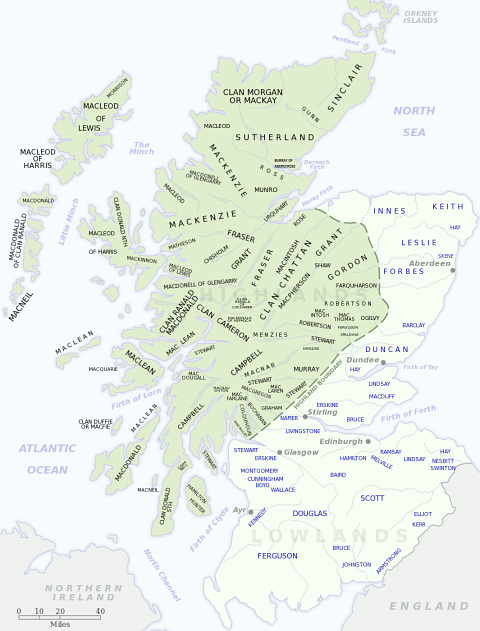
Motto: Srioghail mo dhream (Royal is my race)
Historic Seat: Meggernie Castle
District: Argyll
Associated Surnames: Black, Bowers, Bowmaker, Brewer, Caird, Comrie, Dochart, Docharty, Gregorson, Gregory, Greig, Grewar, Grier, Grigor, Gruer, Leckie, Lecky, MacAdam, MacAra, MacAree, MacChoiter, MacConnachie, MacCrouther, MacGrewar, MacGrowther, MacGruder, MacGruther, Macilduy, MacLesiter, MacLiver, MacNee, MacNeish, Macney, MacNie, MacNish, MacPetrie, Malloch, Neish, Nish, Peterkin, Petrie, Skinner, Stringer, White, Whyte
Associated Tartans:
Early MacGregor Genealogy and History:
(Excerpt from "The Scottish Clans and Their Tartans", James Grant, 1906)
"When I asked a very learned minister in the Islands," says Dr Johnson, "which they considered their most savage clans, "Those that live next the Lowlands, said he; and most true was this of several tribes, among them the MacGregors, whose ancient territory was on both sides of Loch Tay; and these are still called Tuaruith and Deasnuith or north and south."
The septs of the MacGregors, of whom Sir Walter Scott says, "that they were famous for their misfortunes and the indomitable courage with which they maintained themselves as a clan" - a clan the most oppressed for generations - claim a descent from Gregor, third son of King Alpin, who flourished about 787, hence they are usually termed the Clan Alpin, and their proud motto is "Srioghail mo dhream" - "Royal is my race"; and one individual tribe of these retains the same name. They had at one time very extensive possession in Argyllshire and Perthshire, which they imprudently continued to hold by the còir a' chlaidheinah, that is, by the right of the sword; thus the Earls of Argyll and Breadalbane gradually found the means to usurp their lands under the pretext of Royal grants.
The MacGregors strove to retain their lands by the cold steel; and this conduct, "though natural," says Sir Walter Scott, "considering the country and the time, was represented at the capital as arising from an untamable and innate ferocity which nothing could remedy save cutting off the tribe of MacGregor, root and branch." They were styled "Lawless Limmers"1 in Parliament; their name was suppressed; and at baptism no clergyman could give the name of Gregor under deprivation and banishment.
Prior to these dark days of the seventeenth century, the MacGregors appear to have been in possession of the lands of Glenorchy in the thirteenth century. In the Ragman Roll of 12962, John of Glenorchy appears. In their genealogy this John is called the son of Gregor; but in the reign of David II the direct line of the chiefs would appear to have ended in an heiress, who, it is said, married a younger son of the House of Argyll. The next chiefs appear to have remained in Glenorchy as tenants of the Campbells, who were relentless in their efforts to usurp all they had.
John Dhu MacGregor of Glenstrae, and Gregor MacGregor of Roro lost their lands by the Campbells. In 1552, Gregor, son of the deceased Sir James MacGregor, Dean of Lismore, became head of an independent sept, but bound himself to Campbell of Glenorchy and his heirs "taking him for his chief in place of the Laird of MacGregor, and giving him his calp."3 Scott says that it has been disputed whether the MacGregors were the real Children of the Mist; and quotes an Act of Council in 1589, proving that they were so.
In 1603 the fierce battle of Glenfruin4 came to pass through the severity with which the Colquhouns executed the barbarous laws against the MacGregors, who retaliated by invading Luss, under Alister of Glenstrae. The Colquhouns were vanquished, and resorted to the device of appearing before the King at Stirling with the pretended shirts of their slain smeared with blood, and hence the MacGregors were more sternly proscribed; but so recently as 1744 MacGregor of Glengyle drew Black Mail as a kind of Lord Warden of the Highland Borders.
In the end of the last and beginning of the present century the proscription laws were in force; but Sir John Murray MacGregor, Bart. of Lanrick, whose father had been A.D.C.5 to Prince Charles was acknowledged as chief by 826 MacGregors capable of bearing arms. The present Baronet is his direct representative.
MacGregor, a French officer, defended Gingee in India in 1759, under Count Lally. His garrison consisted of 1750 men. He defended the hill fort with such valour that he was permitted to march out with the honours of war on the 5th April in that year.
(End excerpt)
Next page: Clan MacIntyre
Footnotes:
1 limmers: scoundrels
2 Ragman Roll(s): Document signed by noblemen and gentry of Scotland acceding allegiance to King Edward I of England, during the time between the Conference of Norham in May 1291 and the final award in favor of Balliol in November 1292; and again in 1296. Read more about the Ragman Rolls at Wikipedia.
3 calp: a gift made by a tenant to his superior in return for his support and protection
4 The Battle of Glen Fruin (1603): The Battle of Glen Fruin was fought on 7 February 1603 at Glen Fruin, near Loch Lomond in Scotland. It was fought between Clan MacGregor and its allies, and Clan Colquhoun and its allies, after two MacGregor clansmen slaughtered a sheep on Colquhoun land. They were discovered, tried, and sentenced to death. The battle was fought to avenge them, resulting in 140-200 dead. According to tradition this number included a group of clerical students who had assembled to watch the battle and were slaughtered by the MacGregors. Read more about the Battle of Glen Fruin at Wikipedia.
5 A.D.C.: Aide-de-camp, personal assistant or secretary to a person of high rank.

Distribution of Scottish clans and families
View larger map at Wikimedia Commons

Browse the Clan MacGregor Tartan Collection with home decor, personal accessories, crafting, paper products, and more.

Clan MacGregor Postcard: Digitally cleaned and enhanced vintage illustration with tartan border.